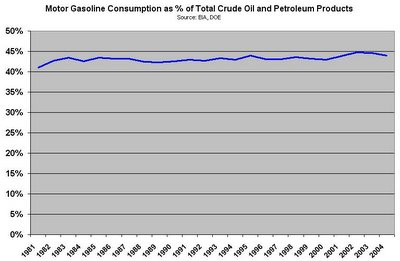If it sounds good, shifts blame from me, and advances my cause, then screw whatever the truth is.
Alas, we here at Captain Capitalism know that the closer you follow and act on the truth (and implement fiscal and monetary policies that are based in facts) the more successful a person, a life and a country you will be (as Evo Morales and the people of Bolivia are soon to find out in reverse).
So when I read this;
 in The Economist, it made me think, "gee, with all the other cars, factories, power plants, etc. that use and consume oil for its energy, do SUV's really have that much of an effect on gas prices?"
in The Economist, it made me think, "gee, with all the other cars, factories, power plants, etc. that use and consume oil for its energy, do SUV's really have that much of an effect on gas prices?"Now it becomes tricky because there isn't any data out there that breaks down how much gas was used to fill up SUV's versus cars. And I could go out and look at all the cars produced versus all the SUV"s produced, then also account for all the used cars, and then extrapolate an estimate of how much gas was being used by SUV's versus cars, but that would be too combersome and inaccurate.
Besides, it turned out to be unecessary. Because sometimes other related data will give you your answer. And I found my answer at the Department of Energy. Here, they list total crude oil and petroleum products used in the US going back to 1981. They break this down then between airplane fuel, power plants, heating oil, etc., including total motor gasoline consumption.
I calculated the percent of total crude oil and petroleum products that was used in motor gasoline comsumption, thinking that if SUV's really were to blame for higher oil prices, then we'd see an upward trend, showing that as SUV's guzzled more and more gas, then motor gasoline would consume a higher and higher percentage of our total petroleum consumption.
Well, here you go.
 It seems that the advent of SUV's has had no discernable effect on the demand for oil relative to other users of oil. Motor gasoline still consumes roughly 43% of all petroleum, just as it has the past 20 years. Of course, cars have become more fuel efficient, and one could make a good argument that SUV's counter this, but the net effect is nothing. SUV's haven't bolstered oil prices as much as stabilized them.
It seems that the advent of SUV's has had no discernable effect on the demand for oil relative to other users of oil. Motor gasoline still consumes roughly 43% of all petroleum, just as it has the past 20 years. Of course, cars have become more fuel efficient, and one could make a good argument that SUV's counter this, but the net effect is nothing. SUV's haven't bolstered oil prices as much as stabilized them.
No comments:
Post a Comment